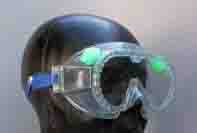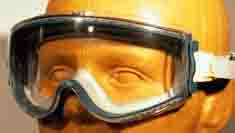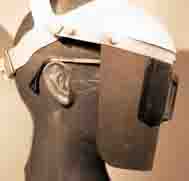 |
||||
|
|
||||
Back to table of contents |
||||
| Eye Hazards for Emergency Response and Disaster Recovery |
| Common hazards |
|
| Common injuries |
|
| Back to table of contents |
| 4 Points to Eye Safety |
| 1. Have a safe work environment |
|
| 2. Evaluate your safety hazards |
|
| 3. Wear the proper eye and face protection |
|
| 4. Prepare for eye injuries and first aid needs |
|
| Back to table of contents |
|
|
|
|
|
| Goggles–better protection |
|
 |
 |
|
Indirect-Vented
Goggles
|
|
|
|
|
| Hybrid safety glasses/goggles–better protection | |
|
|
|
For
greater impact and face protection use a shield over safety glasses/goggles
|
|
| Face Shields–Additional protection | |
|
|
 |
Clear
face shields
with crown protector (may be mounted on hard hat) |
|
|
| Welding |
|
 |
Use
the darkest shade possible
|
|
|
Torch
soldering
Torch brazing/cutting Gas welding Electric arc welding |
1.5-3
3-6 4-8 10-14 |
|
|
Use
Z136 eye protection for laser light hazards (NOT Z87)
|
||
| Note: The examples shown are for illustration purposes only and do not imply endorsement by the U.S. Government |
| Photos courtesy of Dr. Paul Vinger, Tufts Medical School |
|
|
| Respirators–Full face & half-mask |
|
| Back to table of contents |
| Eye Safety for Prescription Lens Wearers |
|
Use
polycarbonate
or Trivex® lenses
for the best impact protection in prescription safety glasses.
|
| Prescription Safety Glasses |
|
|
Use
ANSI Z87.1 Certified
Safety Eye Protection Look for the Z87mark on the frame or lens |
| Caution – Brush, shake, or vacuum dust and debris from hardhats, hair, forehead, or the top of the eye protection before removing protection. Beware of rubbing eyes with dirty hands or clothing. Clean eyewear regularly. |
| Back to table of contents |
| First Aid for Eye Injuries |
|
Specks in the Eye |
|
| Cuts, Punctures, Objects Stuck in the Eye |
|
| Chemical Burns |
|
| Blows to the Eye |
|
| Back to table of contents |
| Information Resources | |
Occupational
Safety and Health Administration Prevent
Blindness America International
Safety Equipment Association American
Society of Safety Engineers
|
|
|
September
2001
|
|